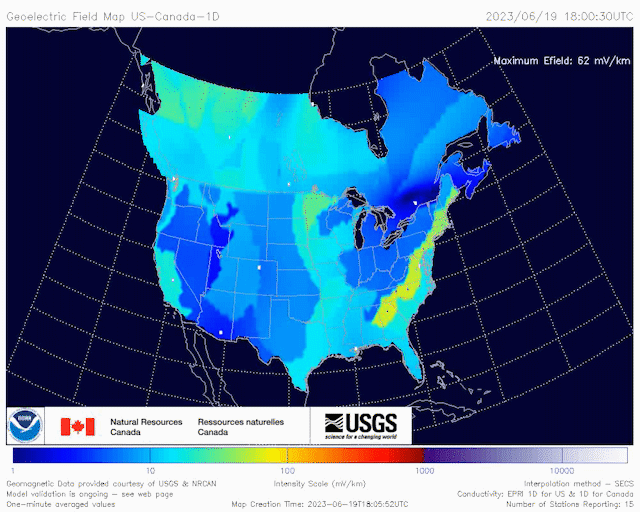Increased spatial resolution will enhance nowcasts of hazardous geoelectric fields induced during geomagnetic storms
June 21, 2023 – When severe and extreme geomagnetic space weather storms occur, they can generate unexpected currents in electric power transmission lines at the surface, putting the stability of electrical grids at risk. Providing accurate and timely information that allow grid operators to protect their systems is one of the primary missions of NOAA’s Space Weather Prediction Center.
This week, NOAA upgraded the model it uses to estimate these geoelectric fields to improve nowcasts of regional space weather impact information for electric power operators. Improvements in the model, now called the U.S.-Canada Geoelectric Field Model, include more accurate outputs of the geoelectric field at Earth’s surface and expanded coverage to Canada, which increases situational awareness for the operation of the 37 major power transmission lines that connect the two countries. It will replace the Geoelectric Field Model, launched in 2019, that only covered the U.S.
Jointly developed by NOAA, the U.S. Geological Survey (USGS) and the Natural Resources Canada/Canadian Hazards Information Service (NRCan/CHIS), this is the primary model that can be used by electric power managers for regional assessment of space weather hazards over the US-Canada operating domain. The upgraded model delivers graphical maps of the U.S and Canada and gridded data files, updated every minute, that indicate both the strength and direction of the electric fields induced by the geomagnetic storm.
 |
| NOAA's U.S.-Canada Geoelectric Field Model delivers nowcasts of regional space weather impact information for electric power operators. |
The geoelectric field strength for a given location is determined by the strength of the space weather disturbance and the properties of the local earth conductivity. Areas with relatively higher earth resistivity typically see higher geoelectric fields at the surface and have a higher level of risk for impacts to the electrical power grid.
Once the geoelectric field is known, the level of geomagnetically induced currents in the power grid can be calculated, and the potential impact on the power grid can be assessed. When geoelectric currents are induced in man-made conductors such as power transmitters and pathways like transmission lines, unexpected and sometimes problematic effects can occur, such as voltage swings, unexpected loading due to transformers that are being affected, risk of voltage collapse in the more extreme cases, risks of false tripping of safety switches, and risk of heating in transformers that exceeds normal operating limits.
"Working closely with power grid operators, our federal partner, USGS, and the Canadian Hazards information service, we built a new level of resilience to the impacts of space weather on Earth,” said Clinton Wallace, Director of NOAA Space Weather Prediction Center. “This model upgrade comes at the right time to provide the electric power industry better data to act on as activity on the Sun increases the closer we get to solar maximum.”
"The notable improvements of the updated geoelectric field model in the U.S. have been made possible through enhanced ground-based geomagnetic monitoring at USGS, and a growing database of critical data,” said Kristen Lewis, USGS manager of geomagnetic operations. "The USGS values the intra-governmental and international scientific collaboration with NOAA and NRCan, and the updated model is the result of this successful partnership.”
Model improvements:
Resources:
Space weather forecasting and impacts: What you need to know
Time-lapse and timeline of Solar Cycle 25
Compact Chronograph on GOES-U
Space weather newsroom
USGS Geomagnetism Program
NOAA’s Space Weather Prediction Center is the official government source for issuing warnings and alerts to help federal partners, public utilities and business interests mitigate impacts of space weather. For more on space weather, follow us on Facebook and Twitter.
The U.S. Geological Survey provides science for a changing world. Learn more at www.usgs.gov or follow us on Facebook @USGeologicalSurvey, YouTube @USGS, Instagram @USGS, or Twitter @USGS.
Contacts:
Maureen O’Leary, NOAA Communications, maureen.oleary@noaa.gov
Theo Stein, NOAA Communications, theo.stein@noaa.gov
Heidi Koehler Koontz, USGS Communications, hkoontz@usgs.gov